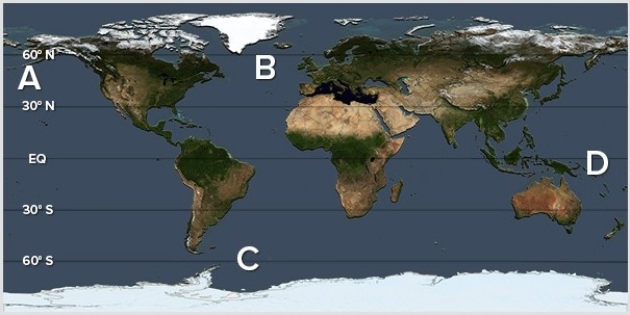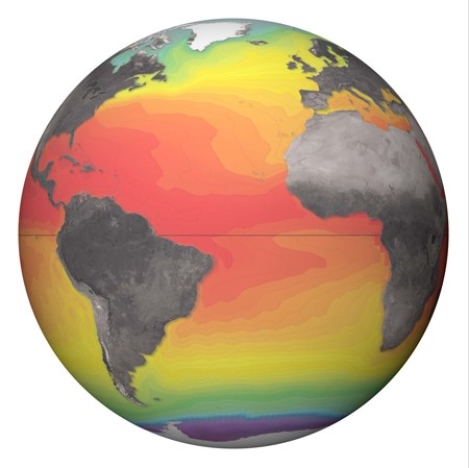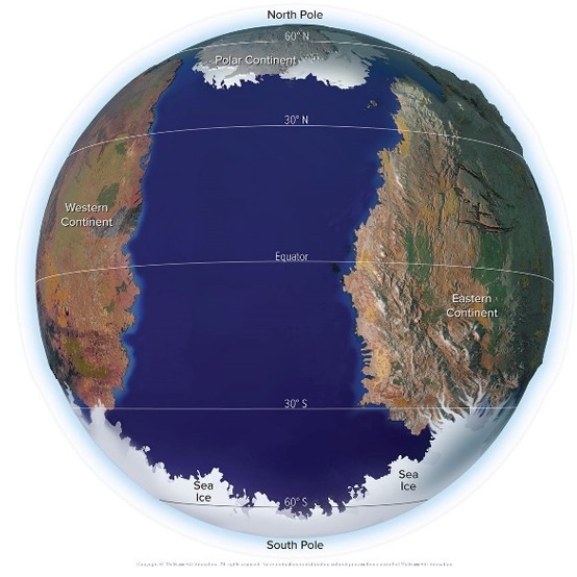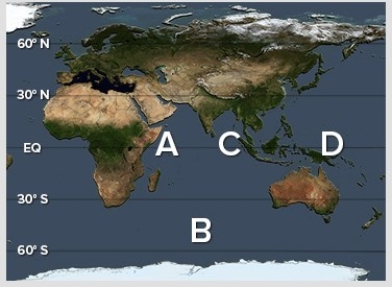A) rising,unstable air where much latent heat is released.
B) descending,stable air where much latent heat is released.
C) warm water is forced to the surface due to upwelling.
D) thermoclines near the surface when the sun is closer to the earth.
F) All of the above
Correct Answer

verified
Correct Answer
verified
Multiple Choice
During the cold phase (La Niña) ,
A) higher than normal pressures form across the southern United States.
B) lower than normal pressures form across the southern United States.
C) higher than normal pressure are typically centered over Hudson Bay.
E) All of the above
Correct Answer

verified
Correct Answer
verified
Multiple Choice
Which of the following locations is associated with sinking of cold saline waters forming the North Atlantic deep waters (NADW) ? 
A) A
B) B
C) C
D) D
F) B) and C)
Correct Answer

verified
Correct Answer
verified
Multiple Choice
Storms leaving the east side of the Icelandic Low and Azores High will be steered to the
A) northeast if mainly under the influence of the Icelandic Low.
B) northeast if mainly under the influence of the Azores High.
C) southeast if mainly under the influence of the Icelandic Low.
D) southwest if mainly under the influence of the Azores High.
F) None of the above
Correct Answer

verified
Correct Answer
verified
Multiple Choice
As a result of cold currents,July SST's are coldest 
A) along the equator.
B) along the axis of the Atlantic Ocean.
C) on the east coasts of continents.
D) on the west coasts of continents.
F) A) and B)
Correct Answer

verified
Correct Answer
verified
Multiple Choice
In polar areas,
A) as ice melts,water's salinity increases and density decreases.
B) as ice forms,water's salinity decreases and density increases.
C) as ice forms,water's salinity increases and density increases.
D) as ice melts,water's salinity increases and density increases.
F) B) and D)
Correct Answer

verified
Correct Answer
verified
Multiple Choice
Midlatitude waters are generally fresher than polar or subtropical zones because
A) more evaporation,more frontal precipitation.
B) more evaporation,less frontal precipitation.
C) less evaporation,less frontal precipitation.
D) less evaporation,more frontal precipitation.
F) A) and B)
Correct Answer

verified
Correct Answer
verified
Multiple Choice
This image shows the hypothetical planet in the investigation for the ocean interactions chapter.What type prevailing winds are most likely between 60° N and the North Pole? 
A) Trade winds
B) Westerlies
C) Polar easterlies
D) No winds
F) All of the above
Correct Answer

verified
Correct Answer
verified
Multiple Choice
With height,wind speed in the atmosphere would ________.With depth,the effect of wind on the water column would ________.
A) increase; decrease
B) increase; increase
C) decrease; decrease
D) decrease; increase
F) A) and D)
Correct Answer

verified
Correct Answer
verified
Multiple Choice
During a La Niña phase,excess warm water accumulates in 
A) A.
B) B.
C) C.
D) D.
F) B) and C)
Correct Answer

verified
Correct Answer
verified
Multiple Choice
Which of the following types of data would be the best indication of the phase of the Pacific Decadal Oscillation (PDO) ?
A) Sea-surface temperatures in the Pacific offshore of Alaska
B) Air-pressure differences between Perth,Australia and Tibet
C) Drought in Africa
D) Temperature of the Gulf Stream
F) All of the above
Correct Answer

verified
Correct Answer
verified
Multiple Choice
In regard to ocean salinity,temperature,and density,
A) heavy tropical rainfall increases salinity and decreases density
B) high evaporation in subtropical waters decreases salinity and increases density
C) ice formation in polar zones decreases salinity and density
D) ice formation in polar zones increases salinity and density
F) All of the above
Correct Answer

verified
Correct Answer
verified
Multiple Choice
A negative phase of the Indian Ocean Dipole (IOD) results in warmer than average surface waters at ________ and cooler than average waters at ________. 
A) A; C
B) A; D
C) C; A
D) C; B
F) B) and D)
Correct Answer

verified
Correct Answer
verified
Showing 81 - 93 of 93
Related Exams